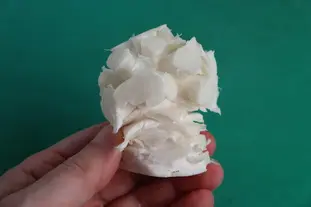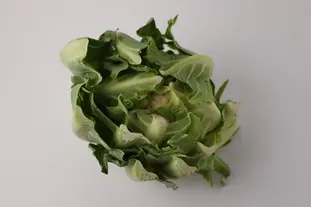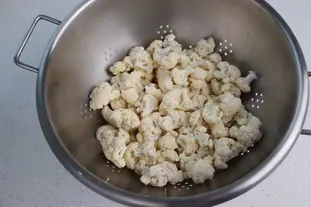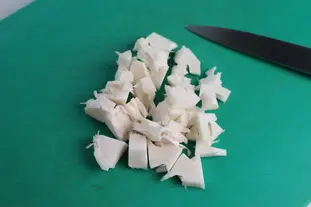The blog of cooking-ez.com
The "pith" of the cauliflower

When using cauliflower in a recipe, there is a lot of preparation work at the beginning: removing the leaves, taking the tops or florets, etc.
It's a bit tedious, but in the end you're left with the best of the cauliflower, ready to be used in your recipe.
It's a bit tedious, but in the end you're left with the best of the cauliflower, ready to be used in your recipe.
8,382 14 4.9
Last modified on: February 5th 2022
Keywords for this post:CauliflowerVegetablesBroccoliRecoveryTrimmingsLeftoversUseThe "pith" of the cauliflower
We usually go through these 3 steps:
And it is only afterwards that the recipe really begins, the tops go into the cooking process for example.
But once we're done, the work surface is covered with cauliflower leaves and trimmings, and in particular with this:
Which is the center rib of the cauliflower, on which all the heads you patiently cut and removed were hanging.
This big white thing, which french chefs curiously call "the pith", we would be tempted to throw it in the compost with the rest of the trimmings, but that would be a shame.
In fact, it can be eaten, like the tops, you just have to cut it into pieces and then treat it like the rest of the cauliflower.
You will notice that, depending on the freshness of the cauliflower, it is slightly harder than the rest, but don't worry: start cooking with only the pith for 1 minute, and then continue by adding the rest, in the usual way.
Note that this process can be applied to other cabbages: broccoli, romanesco among others.
To sum up: Do not throw away the center of cauliflower, broccoli or romanesco cabbage, this part can be cooked with the rest of the vegetable.



And it is only afterwards that the recipe really begins, the tops go into the cooking process for example.
But once we're done, the work surface is covered with cauliflower leaves and trimmings, and in particular with this:

Which is the center rib of the cauliflower, on which all the heads you patiently cut and removed were hanging.
This big white thing, which french chefs curiously call "the pith", we would be tempted to throw it in the compost with the rest of the trimmings, but that would be a shame.
In fact, it can be eaten, like the tops, you just have to cut it into pieces and then treat it like the rest of the cauliflower.

You will notice that, depending on the freshness of the cauliflower, it is slightly harder than the rest, but don't worry: start cooking with only the pith for 1 minute, and then continue by adding the rest, in the usual way.
Note that this process can be applied to other cabbages: broccoli, romanesco among others.
To sum up: Do not throw away the center of cauliflower, broccoli or romanesco cabbage, this part can be cooked with the rest of the vegetable.
Lasts posts
Wipe meats and fish before cooking
When you want to cook meat or fish, there's a very simple yet very important step to take before you even start: It's to dry, or wipe, each side of the meat or fish, sometimes called "dabbing" or "sponging". But why? And how? Let me explain.2,0825 April 14th 2024
Toss the salad
When you've finished preparing a salad, green or otherwise, it's usually time to add the dressing and toss. It's often said to "toss the salad", which means to season and mix. Is it easy? Not so easy...3,2785 March 8th 2024
Half milk, half cream
In a multitude of recipes, savoury or sweet, milk is used as the main ingredient, or at least as the main liquid ingredient. Milk is used instead of water, for example, because milk contains a proportion of fat, which adds roundness and softness to the recipe. This mellowness is very pleasant on...3,169 February 27th 2024
Cutting soft cheeses
As you may have already noticed, when you have to use a "soft" cheese in a recipe - their exact name is "soft cheese" - such as Camembert, Munster or Mont d'or, it's not easy to make anything other than thick slices.3,1465 February 20th 2024
It's spinning too fast!
When you need to grate or slice vegetables, you generally use an electric machine that does all the work: a food processor, a mixer with a "slicer" extension or similar. Are these machines really suitable? Generally speaking, yes of course, but there's one criterion that often poses a problem,...6,1675 November 12th 2023
Other pages you may also like
Fruits which can ruin your jelly
There are many ways of making a fruit mousse, but one of the simplest is to prepare a fruit jelly (basically a fresh fruit coulis with gelatine) and then mix this jelly before it sets completely with whipped cream. The result is perfect for filling a charlotte, for example. But do beware;...68K4.0 March 6th 2013
Tranché, dissociated, failed, in short... missed!
When preparing a sauce or a cream, there's always a (small) risk that the creamy preparation you're working on will suddenly separate into two parts of different textures: a liquid part, for example, and a more or less solid part, or even become lumpy. It's terribly frustrating, but we'll see...5,6705 June 19th 2023
The golden-brown finish on puff pastry
Let's take a look at the tricky matter of producing puff pastry with an attractive, golden-brown finish. French pastry chefs call this "dorure" (literally, "gilding"). Behind this quirky term there lurks a real problem (and the solution): when using puff pastry (pâte feuilletée) for a pie, or...40K 24.6 February 8th 2018
The right weight of pastry for a pie
Let's try to solve a thorny problem: How much dough will I need when I make my next pie? You're planning to make a pie, you're going to use your favourite mould or circle, but how much pastry will you need to fill it completely with a well spread pastry, without being too thin, or on the contrary...58K4.3 March 20th 2020
The 3 secrets of Parisian flan
A flan Parisien, or boulanger, is a simple yet delicious cake. A cream, a mixture of milk, eggs and sugar, is poured into a raw pastry base and baked in the oven until the pastry and cream are cooked. This is the simplest version of the recipe, probably the original one, but nowadays the cream...7,6324.7 July 21th 2023
Post your comment or question
Follow this page
If you are interested in this page, you can "follow" it, by entering your email address here. You will then receive a notification immediately each time the page is modified or a new comment is added. Please note that you will need to confirm this following.
Note: We'll never share your e-mail address with anyone else.
Alternatively: you can subscribe to the mailing list of cooling-ez.com , you will receive a e-mail for each new recipe published on the site.









